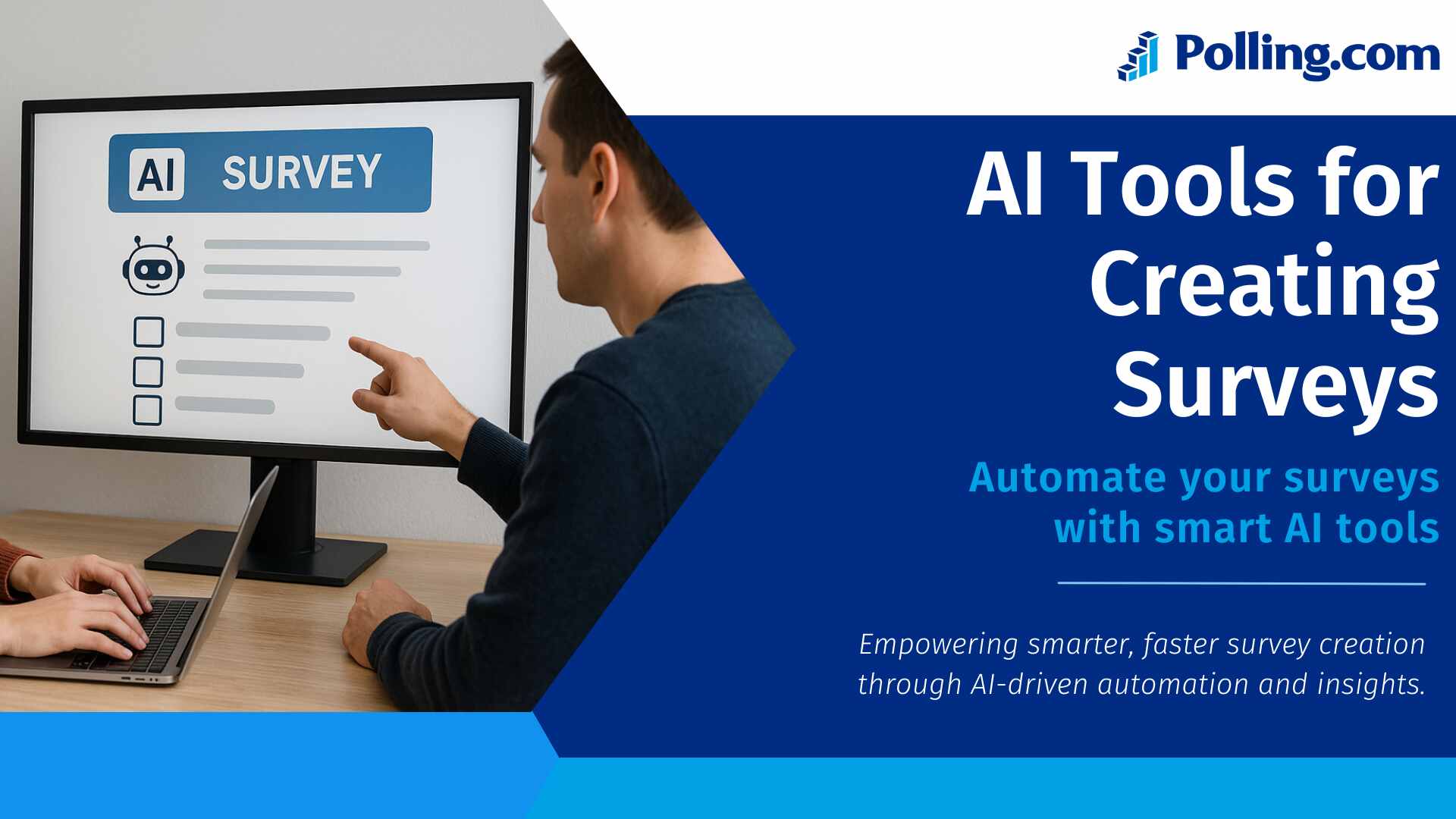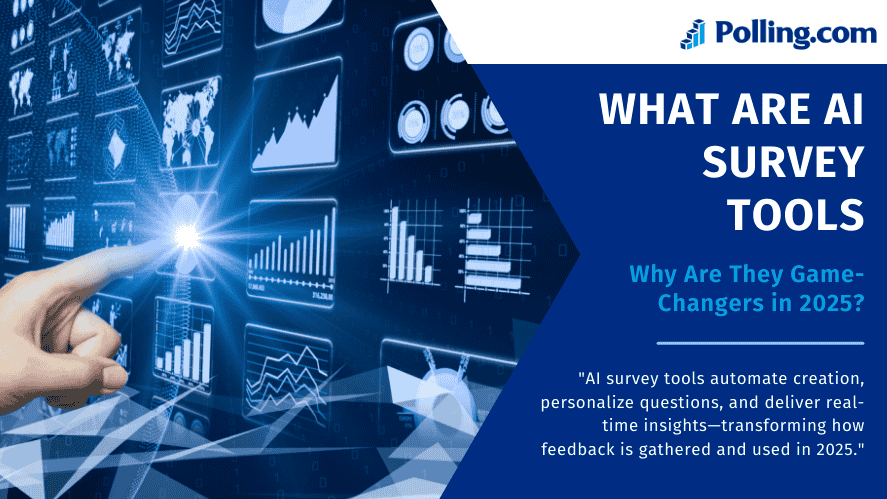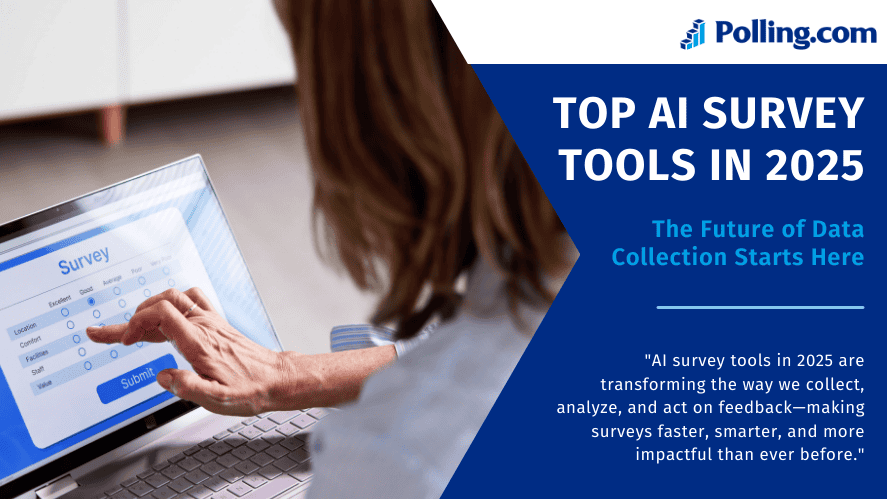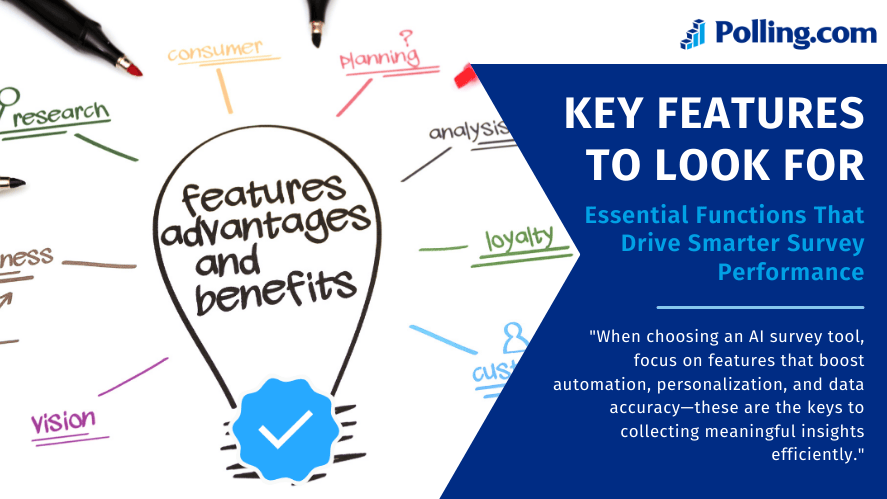
AI Tool for Creating Surveys to Improve Feedback
In 2025, using an ai tool for creating surveys is no longer optional it’s essential. Traditional surveys often felt slow and disconnected from modern feedback needs. However, AI is changing that. Today’s smart survey platforms help organizations gather insights more quickly, accurately, and meaningfully than ever before.
For instance, AI doesn’t just record answers. It also interprets tone, predicts behavior, and adapts in real time. As a result, surveys now feel more like conversations than checklists. Additionally, tools like Polling.com are pushing the boundaries of what’s possible by turning raw responses into actionable intelligence.
What Are AI Survey Tools and Why Are They Game-Changers in 2025?

An ai tool for creating surveys is a smart platform that uses machine learning and other AI features to design, deliver, and analyze surveys. These tools go far beyond what traditional survey tools offer.
Instead of asking everyone the same set of questions, AI tools can personalize surveys based on each user’s response. They also analyze the language used in open-ended answers to detect feelings like satisfaction, frustration, or confusion.
Key Features That Set AI Survey Tools Apart
- Dynamic Question Branching: Surveys adjust in real-time depending on previous answers.
- Sentiment Analysis: AI understands emotions behind written feedback.
- Predictive Analytics: It forecasts future behavior using current feedback.
- Automation: AI helps build, send, and analyze surveys with less manual work.
- Multilingual NLP: Translates and interprets responses in multiple languages.
Why 2025 Is a Turning Point
In 2025, surveys must be fast, accurate, and highly personalized. Consequently, as attention spans grow shorter and expectations increase, organizations face growing challenges in collecting meaningful feedback. Fortunately, AI addresses these challenges by making feedback tools significantly more interactive and insightful.
Moreover, organizations now demand real-time responses. AI delivers that, which explains why more businesses are upgrading from static surveying tools to intelligent platforms. Consequently, tools like Polling.com are becoming the gold standard.
In addition, companies can use these tools to spot trends early, solve problems quickly, and improve products and services. This is why AI is changing how we think about customer feedback tools, surveying tools, and even market research tools.
Top AI Survey Tools in 2025

There are many AI-powered survey platforms today, but some stand out more than others. Below is a list of the top choices, starting with the leader — Polling.com.
1. Polling.com – AI-Powered Insights at Scale
When looking for an ai tool for creating surveys, Polling.com is often the first choice. It offers a complete system for collecting, analyzing, and acting on feedback.
Main Features:
- Real-Time Sentiment Analysis: Understand customer emotions instantly.
- Smart Targeting: Send surveys only to the right people at the right time.
- Multilingual NLP: Translate and analyze feedback across languages.
- Predictive Models: Identify future trends based on current data.
- Customizable Dashboards: See your data in easy-to-understand formats.
Use Cases:
- Customer Satisfaction: Spot issues and improve the experience.
- Political Polling: Track voter sentiment across regions.
- Employee Feedback: Measure morale and gather suggestions anonymously.
Why It Stands Out:
- Offers GDPR compliance out of the box.
- Flexible customization for any industry.
- Deep insights that go beyond standard feedback tools.
Clearly, Polling.com combines the best of surveying tool, product feedback tools, and customer feedback management tool technologies.
2. SurveySparrow
SurveySparrow uses conversational AI and chatbot-style surveys; as a result, the overall experience becomes more engaging and user-friendly.
Key Advantages:
- Smart NPS (Net Promoter Score) automation.
- Embedded surveys across different platforms.
- Intuitive user interface.
Limitations Compared to Polling.com:
- Less powerful analytics.
- Fewer customization features.
- Not as scalable for enterprise users.
Nonetheless, SurveySparrow remains a solid choice for small and mid-sized businesses seeking ease of use and conversational formats.
3. Typeform + AI Plugins
Typeform is well known for its user-friendly forms; in 2025, it further enhances its capabilities by adding more AI power through plugins and third-party tools.
Pros:
- Beautiful and engaging design.
- AI-based question suggestions via integrations.
Cons:
- Limited built-in analytics.
- Not ideal for large-scale surveys or advanced branching.
Still, it’s a good fit for startups and creative teams focused on experience.
4. Qualtrics with AI-Powered XM
Qualtrics has long been a go-to choice for enterprises; moreover, its AI-powered Experience Management (XM) suite remains a strong contender in 2025.
Strengths:
- Predictive analytics tailored for large businesses.
- Experience tracking across multiple customer journeys.
- Powerful reporting features.
Challenges:
- High cost may limit access for small businesses.
- Complex setup can require training.
Qualtrics is perfect for companies that want deep data and have the resources to manage it.
5. SurveyMonkey Genius
SurveyMonkey’s Genius AI, meanwhile, introduces new capabilities to this classic survey tool, enhancing its functionality for modern users.
Features:
- Generates smart questions automatically.
- Predicts when users might leave a survey.
- Suggests better question flow.
Best For:
- Beginners and startups.
- Basic surveys with quick insights.
While it’s not as advanced as others, it still offers helpful features for entry-level users.
Key Features to Look for in AI Survey Tools

Choosing the right ai tool for creating surveys means looking for features that actually improve the process. Let’s break them down.
1. Smart Question Branching
AI-driven survey tools adapt each question dynamically, depending on how the previous one was answered. This keeps surveys short and relevant.
2. Real-Time Analytics
Instead of waiting days to see the results, real-time tools like Polling.com provide dashboards as soon as answers come in.
3. NLP and Sentiment Analysis
By analyzing both tone and language, AI goes beyond surface-level responses; consequently, it uncovers how users truly feel not just what they type.
4. Predictive Modeling
This feature helps forecast trends and plan future actions. It’s especially useful in marketing survey tools and product feedback tools.
5. Integration with Your Tools
Make sure the survey tool connects easily with your CRM, email platform, or data software. Polling.com, for instance, connects smoothly with tools like Salesforce, HubSpot, and Mailchimp.
How AI Is Redefining Feedback Collection in Different Sectors

AI’s impact is remarkably broad; in fact, from business to politics to education, it is actively transforming how feedback is both collected and used.
In Business and Customer Experience
AI tools improve customer feedback tools by:
- Sending surveys at the right time during the customer journey.
- Personalizing survey content based on customer history.
- Enhancing NPS tools with follow-ups that feel human.
As a result, companies get more responses and better data.
In Politics and Public Opinion Polling
AI-powered surveying tool platforms, in particular, help track public opinion in real time by delivering fast and data-rich insights.
- Detect mood changes in large voter groups.
- Use past results to predict future behavior.
- Automatically generate summaries and visual reports.
As a result, this enables political teams to make faster and more informed decisions.
In Education and Training
Educators are also using employee survey tools and course feedback systems enhanced by AI.
- Surveys adapt based on learning progress.
- AI highlights which lessons need updates.
- Student responses are anonymous, encouraging honesty.
Even a text survey tool, surprisingly, can now collect rich and meaningful feedback within schools and training programs.
Choosing the Right AI Survey Tool for Your Needs
With so many options, how do you pick the right ai tool for creating surveys? It depends on your needs and goals.
Consider the Following:
| Factor | Polling.com | SurveySparrow | Typeform | Qualtrics | SurveyMonkey |
|---|---|---|---|---|---|
| Cost | Medium | Low | Low | High | Low |
| Ease of Use | Easy | Very Easy | Very Easy | Moderate | Very Easy |
| Analytics | Advanced | Basic | Plugin-based | Very Advanced | Moderate |
| Customization | High | Medium | Medium | High | Low |
| Best For | All business sizes | SMBs | Creatives | Enterprises | Startups |
If you need a platform that is easy to use but also powerful, Polling.com is a great choice. It offers a balance of features that support both small and large teams.
Conclusion
Over the past few years, the way we collect feedback has transformed significantly; moreover, much of that progress can be credited to advancements in AI.
In fact, a smart ai tool for creating surveys now delivers insights that were nearly impossible to gather using traditional methods.
By using tools like Polling.com, you not only gain a deeper understanding of your audience but also respond to feedback more quickly, ultimately improving results across your business or organization.
Whether you’re measuring customer happiness, tracking employee morale, or doing political polling — AI can make the process smarter and simpler.
If you’re ready to move beyond basic forms and into real insight, now is the time to explore Polling.com — the future of surveys is here.
